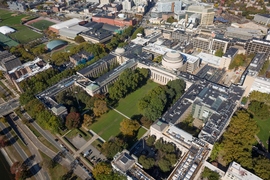MIT has formally joined the Carbon Pricing Leadership Coalition, a global partnership of governments, businesses, and civil society organizations working together with the goal of applying a price on carbon emissions, the predominant cause of climate change.
Jim Yong Kim, president of the World Bank, and Christine Lagarde, managing director of the International Monetary Fund, officially launched the coalition at the Paris climate talks last November. Its membership includes more than 20 national and subnational governments, more than 90 major companies, and dozens of leading nonprofit organizations. MIT is the second university to join the coalition after Yale.
L. Rafael Reif, the president of MIT, accepted the invitation to join the CPLC in a letter sent May 19 to the World Bank.
“Remarkable progress in low-carbon energy innovation and commercialization — happening here at MIT and at universities, companies, and government labs around the world — is a reason for great optimism,” Reif wrote in the letter. “Yet we know that without the right incentives in policy, advances in technology alone will not deliver the energy transformation we need to meet the climate challenge.”
In MIT’s Plan for Action on Climate Change, issued in October 2015, MIT’s senior officers described carbon pricing as the kind of “systemic solution” than can help incentivize the switch to low- and zero-carbon sources of energy. Under carbon pricing, emitters of carbon pollution typically must pay a charge on each ton of carbon emissions they produce. This creates a market incentive for encouraging entities throughout the economy — from households to power plants — to shift to cleaner sources of energy.
Maria Zuber, MIT’s vice president for research, said that over the last couple of years, as the MIT community discussed potential strategies for addressing climate change, carbon pricing emerged as a strong point of consensus.
“If you ask MIT economists and policy experts what we should do about climate change, chances are they will tell you: Put a price on carbon emissions,” said Zuber. “Along with increased funding for clean energy research and development, carbon pricing is one of the most effective things we can do to speed up the transition to a zero-carbon economy.”
Carbon pricing policy, including its optimal design and implementation, is a significant area of focus for many MIT faculty members and researchers, including those affiliated with MIT’s Center for Energy and Environmental Policy Research and Joint Program on the Science and Policy of Global Change. Sharing knowledge on best practices is a priority for the Carbon Pricing Leadership Coalition.
In today’s letter, Reif also noted that MIT is exploring how best to incorporate carbon pricing into the Institute’s internal decision making. As a first step, the Department of Facilities is finalizing a carbon calculator for use in campus capital projects.
Below is the text of the letter sent May 19 by President Reif to John Roome, senior director for climate change, at the World Bank Group.
Dear Mr. Roome,
I am honored to accept your invitation for the Massachusetts Institute of Technology (MIT) to join the Carbon Pricing Leadership Coalition.
The urgent threat of climate change demands nothing less than the complete transformation of the global energy system. To help meet this challenge, a vibrant community of MIT faculty members, researchers, students, and alumni are working to develop new sources of low- and zero-carbon energy and bring these innovations to market.
Remarkable progress in low-carbon energy innovation and commercialization — happening here at MIT and at universities, companies, and government labs around the world — is a reason for great optimism. Yet we know that without the right incentives in policy, advances in technology alone will not deliver the energy transformation we need to meet the climate challenge.
As I have learned from leading MIT economists and policy experts, putting a price on carbon is one of the surest mechanisms available to accelerate the transition to low- and zero-carbon energy sources. Indeed, over the last couple of years, as MIT community members have discussed how the Institute could best advance solutions to the climate challenge, supporting carbon pricing emerged as a clear point of consensus.
We look forward to learning from the experiences of other CPLC members and to sharing what we have learned. Membership in the CPLC is a natural and welcome outgrowth of two areas of MIT’s ongoing work:
- We continue to forge partnerships with leaders from government, industry, and civil society interested in enacting carbon pricing through public policies in jurisdictions around the world.
- And we are beginning to explore the most effective ways to incorporate a price on carbon into our internal decision-making.
We are grateful to join you today, steadfast in our conviction that collaboration and engagement among government, industry, academia, and civil society offer the clearest path to meeting the challenge of climate change.
Sincerely,
L. Rafael Reif











